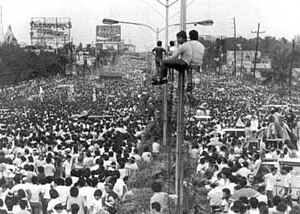
Back الثورة الفلبينية 1986 Arabic People Power Revolution BCL Жоўтая рэвалюцыя Byelorussian Жълта революция Bulgarian Dispac'h an EDSA Breton Revolució del Poder Popular Catalan Rebolusyon sa EDSA sa 1986 CEB EDSA Revolutionen Danish EDSA-Revolution German Επανάσταση των Φιλιππίνων του 1986 Greek
| People Power Revolution | |||
|---|---|---|---|
 Hundreds of thousands of people filling up Epifanio de los Santos Avenue (EDSA), facing northbound towards the Boni Serrano Avenue–EDSA intersection (February 1986) | |||
| Date | February 22–25, 1986 (3 days) | ||
| Location | |||
| Caused by |
| ||
| Goals |
| ||
| Resulted in | Opposition victory
| ||
| Parties | |||
| |||
| Lead figures | |||
| |||
| Number | |||
| |||
| History of the Philippines |
|---|
 |
| Timeline |
|
|
| ||
|---|---|---|
Related |
||
| Part of a series on |
| Political revolution |
|---|
 |
|
|
The People Power Revolution, also known as the EDSA Revolution[a] or the February Revolution,[4][5][6][7] were a series of popular demonstrations in the Philippines, mostly in Metro Manila, from February 22 to 25, 1986. There was a sustained campaign of civil resistance against regime violence and electoral fraud. The nonviolent revolution led to the departure of Ferdinand Marcos, the end of his 20-year dictatorship and the restoration of democracy in the Philippines.
It is also referred to as the Yellow Revolution[8] due to the presence of yellow ribbons during demonstrations (in reference to the Tony Orlando and Dawn song "Tie a Yellow Ribbon Round the Ole Oak Tree") as a symbol of protest following the assassination of Filipino senator Benigno "Ninoy" Aquino Jr.[9] in August 1983 upon his return to the Philippines from exile. It was widely seen as a victory of the people against two decades of presidential rule by President Marcos, and made news headlines as "the revolution that surprised the world".[10]
The majority of the demonstrations took place on a long stretch of Epifanio de los Santos Avenue, more commonly known by its acronym EDSA, in Metro Manila from February 22 to 25, 1986. They involved over two million Filipino civilians, as well as several political and military groups, and religious groups led by Cardinal Jaime Sin, the Archbishop of Manila, along with Catholic Bishops' Conference of the Philippines President Cardinal Ricardo Vidal, the Archbishop of Cebu. It is rightfully remembered as a “Rosary miracle” in the peaceful victory.[11]
The protests, fueled by the resistance and opposition after years of governance by President Marcos and his cronies, ended with the ruler, his family, and some of their supporters fleeing to exile in Hawaii; and Ninoy Aquino's widow, Corazon Aquino, inaugurated as the eleventh President of the Philippines.[12]
- ^ a b Sison, Jose Maria (February 24, 2006). "It was a convergence of various forces". Philippine Daily Inquirer. Retrieved August 4, 2014.
- ^ Araullo, Carolina (March 2, 2000). "Left was at Edsa and long before". Philippine Daily Inquirer. Retrieved August 4, 2014.
- ^ Suarez, Miguel (February 26, 1986). "Marcos' last days filled with errors and humiliation". The Evening Independent. Associated Press. Retrieved August 4, 2014.
She (Imelda) did not tell the crowd by that time all but a few thousand soldiers and officers, mostly those in the presidential guard, had by then turn against Marcos to join Mrs. Aquino's "people power" revolution
- ^ "G.R. No. 88211". www.lawphil.net. Archived from the original on August 3, 2022. Retrieved February 26, 2021.
- ^ Ileto, Reynold C. (June 1993). "The 'Unfinished Revolution' in Philippine Political Discourse". 東南アジア研究. 31 (1): 62–82. hdl:2433/56488. ISSN 0563-8682. Retrieved September 29, 2022.
- ^ "G.R. No. L-82380 April 29, 1988 - AYER PRODUCTIONS PTY. LTD., ET AL. v. IGNACIO M. CAPULONG, ET AL.: April 1988 - Philippine Supreme Court Decisions". www.chanrobles.com.
- ^ "Speech of President Corazon Aquino on the EDSA Flag Raising, February 25, 1987 | GOVPH". February 25, 1987. Archived from the original on December 2, 2022. Retrieved February 26, 2021.
- ^ FRIEND, THEODORE (1988). "The "Yellow Revolution": Its Mixed Historical Legacy". Philippine Studies. 36 (2): 166–182. JSTOR 42633078 – via JSTOR.
- ^ "The Original People Power Revolution". QUARTET p. 77. Archived from the original on February 15, 2008. Retrieved February 28, 2008.
- ^ Kumar, Ravindra (2004), Mahatma Gandhi at the Close of Twentieth Century, Anmol Publications PVT. LTD., p. 168, ISBN 978-81-261-1736-9, retrieved December 2, 2007.
- ^ Escalona, Valerie Joy (October 22, 2024). "The Rosary Miracle of the Philippines". National Catholic Register. Retrieved October 24, 2024.
- ^ "Edsa people Power 1 Philippines". Angela Stuart-Santiago. Archived from the original on December 13, 2007. Retrieved December 3, 2007.
Cite error: There are <ref group=lower-alpha> tags or {{efn}} templates on this page, but the references will not show without a {{reflist|group=lower-alpha}} template or {{notelist}} template (see the help page).

